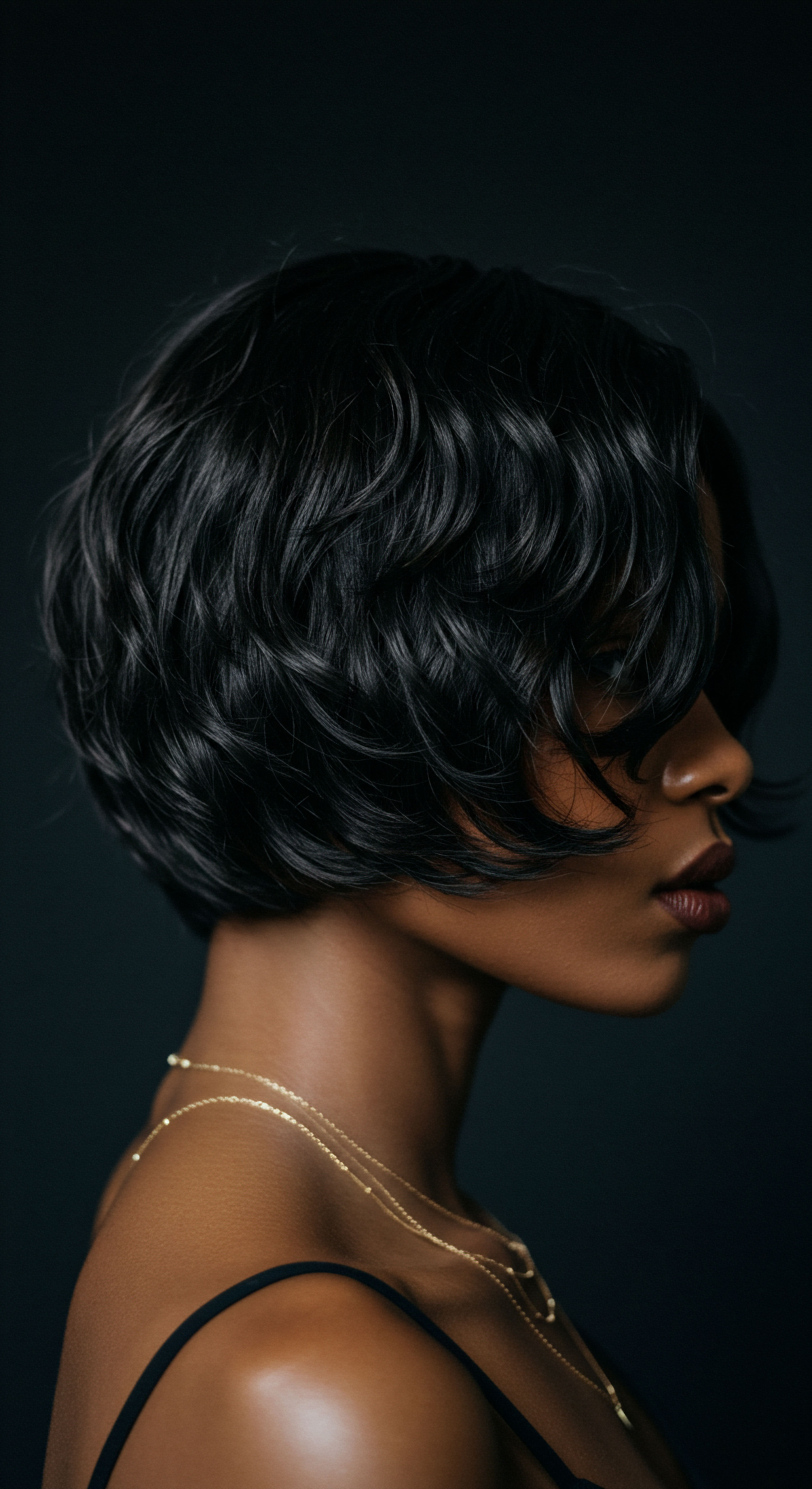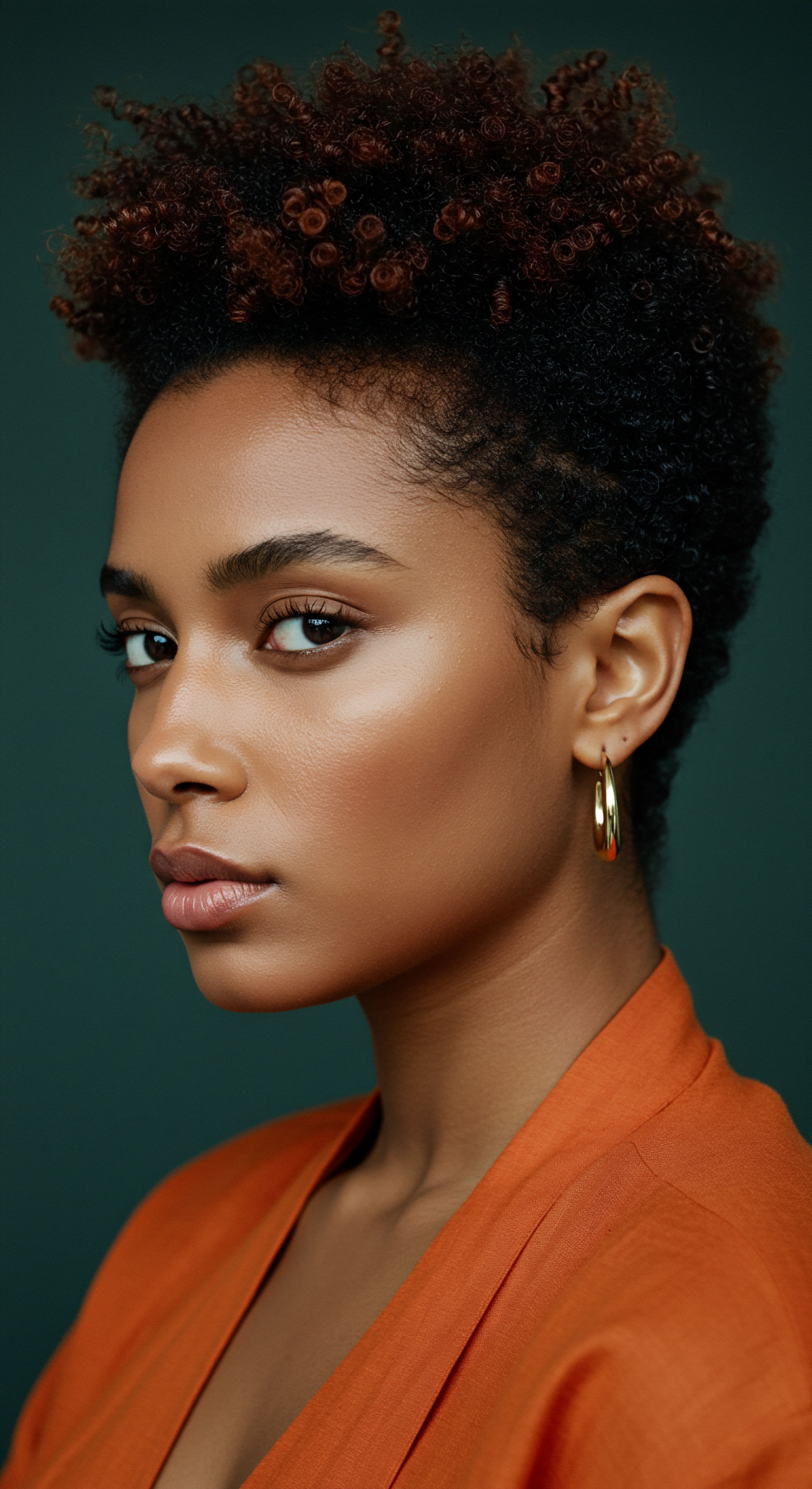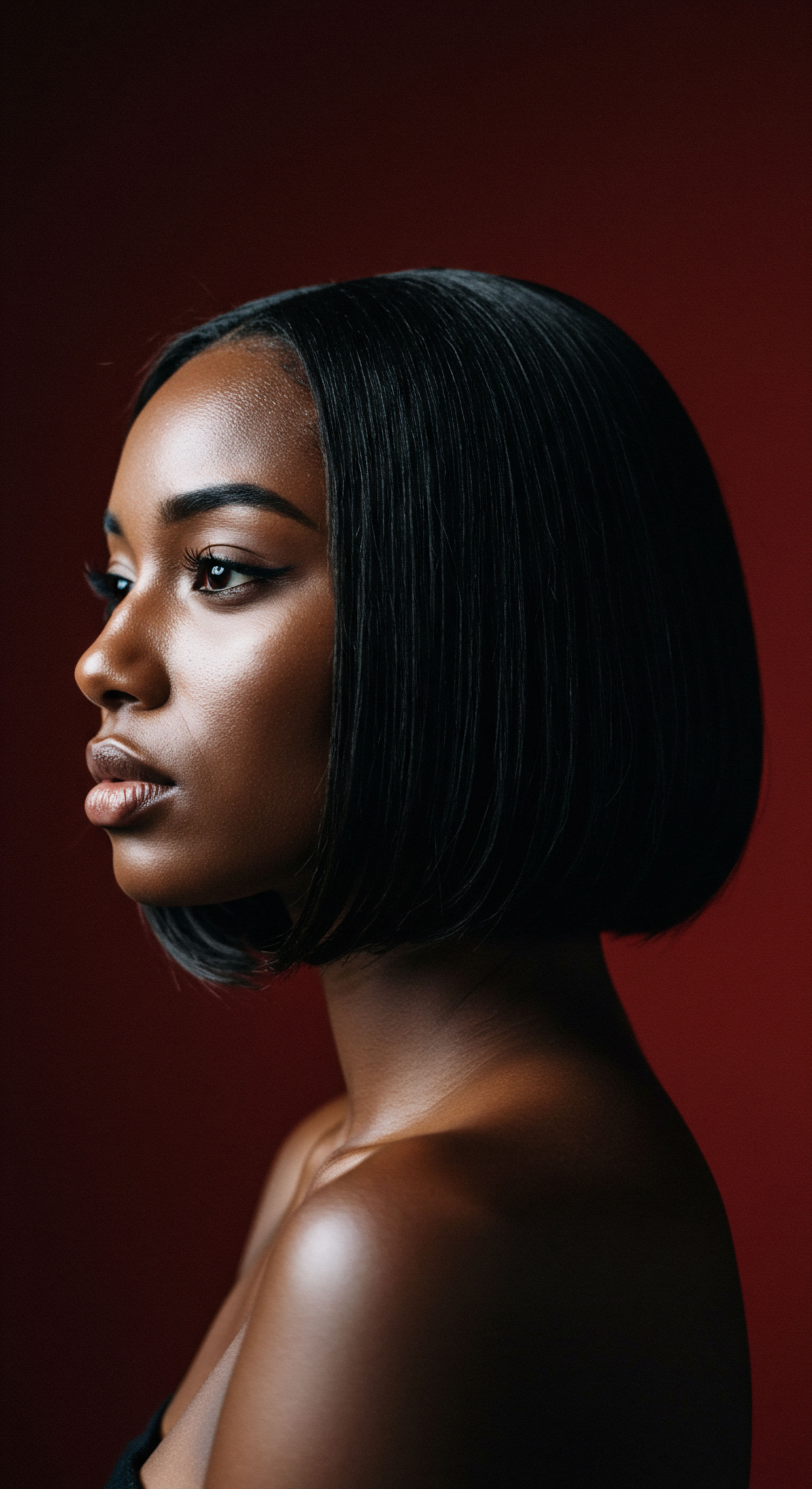
Roots
A quiet whisper from our strands often goes unheard, a subtle conversation about the deepest rhythms of our being. We spend a third of our lives in slumber, a period where the world outside fades, yet within, a symphony of restoration plays on. Could this nightly dance, or its absence, truly echo in the vitality of our hair, particularly for those with textured tresses that speak volumes of heritage and strength? This exploration delves into the foundational truths, the biological undercurrents that connect our sleep to the very life of our hair, a connection more profound than often considered.

The Hair’s Own Rhythmic Life
Every single strand of hair, from its nascent beginnings deep within the scalp to its eventual release, follows a meticulously orchestrated cycle. This cycle, a marvel of biological precision, comprises three primary phases ❉ Anagen, the active growth period; Catagen, a brief transitional stage where growth ceases; and Telogen, the resting phase, which culminates in shedding. These phases are not merely linear steps but rather a continuous, repeating dance, influenced by a multitude of internal signals. Understanding this inherent rhythm is paramount to grasping how external disruptions, such as altered sleep patterns, might cast a shadow upon hair’s natural vitality.
During the deep sleep stages, particularly non-REM, the body shifts into a repair and growth mode. This is a time when cellular turnover intensifies, tissue repair takes place, and the levels of crucial hormones, like melatonin and growth hormone, rise significantly. These internal processes directly support the anagen phase, encouraging active hair growth.

How Sleep Sustains Follicular Health
The hair follicle, that tiny organ nestled beneath the skin, acts as the very heart of hair production. Its health dictates the strength, thickness, and longevity of each strand. Adequate, restorative sleep provides the ideal environment for these follicles to thrive. It facilitates the steady delivery of oxygen and essential nutrients through enhanced blood circulation to the scalp.
When sleep patterns become erratic or insufficient, this vital supply chain can falter, leaving follicles undernourished and potentially weakened. Think of it as a garden needing consistent, gentle rain; without it, even the most resilient plants may struggle to flourish.
The subtle connection between our nightly rest and the vitality of our hair lies in the body’s profound cellular repair and hormonal orchestration during sleep.

What Does Sleep Deprivation Do to Hair Follicles?
A consistent lack of sleep, or fragmented rest, can disrupt the delicate balance within hair follicles. It can prematurely push a greater number of follicles from their active growth phase into the resting phase, leading to increased shedding and a noticeable thinning over time. This shift can occur because the body, under the stress of sleep deprivation, prioritizes immediate survival functions, diverting resources away from processes deemed less critical, such as hair growth. The hair matrix keratinocytes, the cells responsible for hair production, require restorative deep sleep phases for tissue growth and proliferation.
A study published in PNAS (2013) offers a fascinating insight into the hair follicle’s intrinsic biological clock. Researchers observed that hair follicles exhibit a daily mitotic rhythm, with hairs growing faster in the morning than in the evening. This rhythmicity is governed by circadian clock genes, and disrupting these genes, such as BMAL1 and PER1, can delay the progression of the hair growth phase. While this research primarily used mouse models, it highlights the deep, cellular connection between the body’s internal clock and the hair’s growth patterns, suggesting that consistent sleep patterns support this natural, optimal rhythm.
| Hair Cycle Phase Anagen (Growth) |
| Characteristics Active growth, cells divide rapidly. |
| Sleep's Role Supported by increased cell turnover, growth hormone, and melatonin during deep sleep. |
| Hair Cycle Phase Catagen (Transition) |
| Characteristics Brief, growth ceases, follicle shrinks. |
| Sleep's Role Disrupted sleep can prematurely push follicles into this phase. |
| Hair Cycle Phase Telogen (Resting/Shedding) |
| Characteristics Hair stops growing, eventually sheds. |
| Sleep's Role Chronic sleep deprivation can lead to excessive shedding by prolonging this phase. |
| Hair Cycle Phase Maintaining consistent, quality sleep directly contributes to the optimal functioning of each hair growth phase. |

Ritual
As we navigate the daily rhythms of life, our hair becomes a canvas for expression, a source of pride, and often, a subject of our devoted care. The quest for healthy, vibrant hair, especially for those with textured strands, extends beyond the potions and treatments we apply. It intertwines with the very rituals of our daily existence, including the often-overlooked yet profoundly impactful nightly repose.
This section invites a deeper consideration of how our sleep habits, and the routines we build around them, subtly yet powerfully influence the health and appearance of our hair. It’s a conversation about harmonizing our inner biological clock with our outward care practices, moving towards a more complete understanding of hair wellbeing.

The Nighttime Sanctuary for Hair
The hours we spend asleep are not merely a pause from activity; they are a crucial period of repair and regeneration for the entire body, including our hair. This nightly window offers an opportunity to optimize our hair’s environment, protecting it from friction, tangling, and moisture loss that can occur during tossing and turning. For textured hair, which often possesses a more delicate structure and a greater propensity for dryness, these protective measures during sleep become even more significant.
The traditional practice of covering hair at night, prevalent in many cultures, particularly within Black communities, serves as a testament to this understanding. Whether through the use of a silk bonnet, a satin scarf, or a carefully arranged pineapple style, these rituals are not just about preserving a hairstyle for the morning; they are about creating a sanctuary for the hair, minimizing mechanical stress and preserving precious moisture. This self-care ritual, passed down through generations, underscores an intuitive grasp of hair’s needs during rest.

Does a Consistent Sleep Schedule Really Matter for Hair Health?
The body thrives on routine, and our internal biological clock, the circadian rhythm, orchestrates countless physiological processes, including those that influence hair growth. When our sleep schedule is inconsistent, this rhythm can become disoriented. The disruption can lead to an imbalance in hormones that regulate the hair growth cycle, such as melatonin and growth hormone.
A regular sleep pattern helps to synchronize these internal mechanisms, allowing the hair follicles to function optimally through their growth, transition, and resting phases. This consistency contributes to a more predictable and robust hair growth cycle, minimizing premature shedding and promoting overall hair vitality.
Cultivating a consistent sleep routine, alongside protective nighttime hair practices, forms a quiet yet powerful ritual that safeguards hair’s health and natural beauty.

Practical Nighttime Care for Textured Hair
Integrating mindful hair care into a consistent sleep routine can make a noticeable difference.
- Protective Wraps and Pillowcases ❉ Opting for Silk or Satin Pillowcases or wearing a Silk or Satin Bonnet at night drastically reduces friction against hair strands. This simple switch can prevent breakage, tangling, and frizz, particularly beneficial for delicate textured hair.
- Loose Hairstyles ❉ Securing hair in loose braids, twists, or a “pineapple” (a high, loose ponytail) can minimize tension on the scalp and prevent knots. Avoiding tight hairstyles during sleep is paramount.
- Moisture Retention ❉ Applying a light leave-in conditioner or a small amount of hair oil before bed can help seal in moisture, counteracting the natural dryness that textured hair often experiences. This ensures strands remain hydrated and supple overnight.
These simple, intentional actions before bed become part of a larger ritual that honors the hair’s needs, supporting its natural inclination towards health and growth even as we drift into slumber.
| Protective Practice Silk or Satin Pillowcases |
| Hair Health Benefit Reduced friction, tangling, breakage. |
| Why It Works Smooth surface minimizes pulling and snagging compared to cotton. |
| Protective Practice Loose Braids or Twists |
| Hair Health Benefit Prevents knots, maintains curl pattern. |
| Why It Works Keeps strands contained without tension, preserving style and integrity. |
| Protective Practice Moisture Application |
| Hair Health Benefit Hydration, reduced dryness. |
| Why It Works Supports hair's natural moisture barrier against overnight evaporation. |
| Protective Practice Thoughtful nighttime hair care safeguards strands from mechanical stress and moisture loss, promoting overall hair vitality. |

Relay
Beyond the visible changes in our hair and the rhythms of our daily care, there exists a deeper, more intricate conversation between our internal biological clock and the very fabric of our strands. This section ventures into the sophisticated interplay of biological mechanisms, environmental factors, and even cultural undercurrents that connect sleep deprivation to hair growth. It invites us to consider the less obvious pathways, the molecular whispers, and the broader societal echoes that shape our hair’s destiny, moving beyond simple cause and effect to a truly holistic understanding.

The Biochemical Symphony of Sleep and Hair
Sleep is a profound state of biochemical reorganization, where numerous bodily systems reset and restore themselves. When this delicate balance is disturbed by sleep deprivation, a cascade of physiological responses can directly impact hair health.
- Hormonal Imbalance ❉ One of the most significant consequences of insufficient sleep is the dysregulation of hormones. Cortisol, often termed the “stress hormone,” sees elevated levels when sleep is scarce. Chronically high cortisol can prematurely push hair follicles into the resting (telogen) phase, leading to excessive shedding, a condition known as Telogen Effluvium. Furthermore, growth hormone, essential for cellular regeneration and hair follicle growth, is predominantly released during deep sleep. Its reduction can stunt hair growth. Melatonin, primarily known for regulating sleep-wake cycles, also plays a direct role in hair health by stimulating hair follicle cells and extending the anagen (growth) phase. A deficit in melatonin can hinder new hair formation.
- Oxidative Stress ❉ Sleep deprivation can also heighten oxidative stress within the body. This imbalance between free radical production and antioxidant defenses can damage hair follicles at a cellular level, contributing to hair aging and potentially leading to graying and loss. Sleep serves as a protective mechanism against the accumulation of reactive oxygen species (ROS) during wakefulness.
- Circadian Clock Genes ❉ Hair follicles possess their own intrinsic circadian clock, regulated by “clock genes” like BMAL1 and PER1. These genes influence the cell cycle progression within the hair follicle, affecting how quickly hair grows. Disruptions to our systemic circadian rhythm, often a consequence of poor sleep, can in turn affect these local follicular clocks, potentially delaying the anagen phase and impairing hair growth.

The Unseen Toll ❉ Beyond Simple Shedding
The impact of sleep deprivation on hair extends beyond merely increased shedding. It can affect the very quality and structure of the hair that does grow. Poor sleep can compromise blood flow to the scalp, limiting the delivery of vital oxygen and nutrients to the follicles, resulting in weaker, more brittle strands.
The subtle disruption of sleep patterns can cascade into hormonal imbalances, increased oxidative stress, and a disarray of cellular rhythms, collectively impacting hair’s vitality and growth.

Can Sleep Deprivation Affect Hair Pigmentation?
A less commonly discussed, yet significant, consequence of sleep disruption relates to hair pigmentation. Research indicates that sleep deprivation can contribute to increased oxidative stress. This oxidative stress, over time, can lead to a deterioration of cellular structures, including melanocytes, the cells responsible for producing melanin, the pigment that gives hair its color.
A reduction in the activity of tyrosinase, a key enzyme in the melanogenesis process, can result from this cellular damage, potentially leading to premature graying. While not a direct “growth” effect, it underscores the profound, systemic reach of sleep’s influence on hair’s characteristics.

A Cultural and Societal Lens on Sleep and Hair
For many, especially Black women, the intersection of sleep, hair care, and societal pressures presents a complex reality. Research highlights that Black women often experience shorter sleep duration, poorer sleep quality, and a higher prevalence of sleep disorders. These disparities are often linked to systemic factors such as racism, discrimination, demanding work environments, and socioeconomic inequalities.
The nightly ritual of protecting textured hair, whether with bonnets or scarves, while deeply rooted in cultural tradition and self-care, also functions as a response to these external pressures. It is a practical measure to preserve styles and maintain hair health in the face of daily stressors that can compound the effects of sleep deprivation. This practice becomes a quiet act of self-preservation, a way to reclaim agency over one’s hair and well-being amidst challenging circumstances.
A compelling example of sleep’s profound influence on hair, beyond typical shedding, can be found in studies examining hair cortisol concentration (HCC). Hair cortisol serves as a promising biomarker for assessing long-term stress levels. Research has shown that chronic sleep deprivation can lead to elevated HCC, reflecting a sustained stress response within the body.
One study even noted that while many factors contribute to hair loss, sleep deprivation, by increasing cortisol levels, directly impacts the hair growth cycle. This provides a measurable, objective link between sleep quality and the physiological stress that can manifest in hair changes, moving beyond subjective reports to a quantifiable biological response.
| Biochemical Marker Cortisol |
| Sleep Deprivation Effect Elevated levels. |
| Hair Impact Premature telogen phase, increased shedding (telogen effluvium). |
| Biochemical Marker Growth Hormone |
| Sleep Deprivation Effect Reduced release. |
| Hair Impact Stunted hair growth, impaired cellular regeneration. |
| Biochemical Marker Melatonin |
| Sleep Deprivation Effect Lowered levels. |
| Hair Impact Shortened anagen phase, reduced hair follicle stimulation. |
| Biochemical Marker Oxidative Stress Markers |
| Sleep Deprivation Effect Increased production of reactive oxygen species. |
| Hair Impact Hair follicle damage, premature graying, aging. |
| Biochemical Marker The intricate dance of biochemical signals profoundly influences hair health, with sleep acting as a primary conductor. |

Reflection
As we draw our exploration to a close, the threads connecting our nightly rest to the vitality of our hair reveal themselves with compelling clarity. Hair, particularly textured hair, is not merely an aesthetic adornment; it is a living extension of our inner landscape, a sensitive barometer of our overall well-being. The gentle caress of deep sleep, or the jarring disruption of its absence, sends ripples through our biological systems, ultimately influencing the strength, growth, and even the hue of our strands.
To honor our hair, then, is to honor the profound rhythms of our bodies, to listen to the quiet wisdom that whispers from within. It is a reminder that genuine radiance blossoms from a place of holistic care, where the unseen rituals of rest hold as much sway as the visible acts of tending.

References
- Clinikally. (2024). Impact of Sleep Deprivation on Hair Health.
- HHC Clinics. (Medically Reviewed by Dr Ali). (2024). Sleep and Hair Growth – What’s the Connection?
- Centre Clauderer. (2025). Hair and sleep ❉ the importance of the night for hair health.
- Hair Doctors. (2025). Can Lack of Sleep Make You Lose Hair? Uncovering the Connection.
- Treatment Rooms London. (2024). Can A Lack of Sleep Cause Hair Loss?
- MONPURE. (2024). Hair Loss ❉ Is Lack of Sleep Stunting Growth?
- LearnSkin. (2017). How Does the Circadian Rhythm Affect Hair Growth?
- Typology. (2024). The consequences of a lack of sleep on your hair.
- Birmingham Dermatology Clinic. (2024). Melatonin stopping hair loss?
- Longevita Hair Transplant. (2025). Telogen Effluvium ❉ Causes, Reversibility & Treatments.
- Xu, X. Zhang, S. Yang, C. Ma, L. Cao, X. & Liu, Q. (2022). Melatonin’s Role in Hair Follicle Growth and Development ❉ A Cashmere Goat Perspective. Animals, 12(23), 3294.
- Corti Hormonal Research. (2023). Melatonin ❉ A Game-Changer for Hair Growth and Health – In-Depth Analysis.
- DermiMatch Hair Clinic. (2024). Lack of Sleep and Hair Loss ❉ Exploring the Evidence.
- L’Oréal Paris. (2022). How Does Sleep Affect Hair Health & Growth?
- DiStefano Hair Restoration Center. (2025). How Does Sleep Affect Hair Health & Growth?
- Cellustrious. (2023). Sleep Deprivation and Gaming ❉ The Impact on Hair Health.
- Al-Hassany, M. & Al-Hamami, S. (2023). Hair Follicles as a Critical Model for Monitoring the Circadian Clock. Clocks & Sleep, 5(1), 11-23.
- Wang, J. et al. (2013). Local circadian clock gates cell cycle progression of transient amplifying cells during regenerative hair cycling. Proceedings of the National Academy of Sciences, 110(23), 9443-9448.
- Trichology. (2024). Sleep And Hair Growth ❉ Enhance Your Hair Health Through Better Sleep.
- Afrocenchix. (2025). The Link Between Good Sleep and Great Hair ❉ Tips for World Sleep Day.
- Aging-US. (2019). Clock genes, hair growth and aging.
- Geyfman, M. et al. (2012). Circadian Clock Genes Contribute to the Regulation of Hair Follicle Cycling. PLOS Genetics, 8(5), e1002715.
- Sleep.com. (2021). How a Hair Wrap Routine Protects More Than Just My Hair.
- HairFree & HairGrow. (2023). Sleep and Hair Loss. Relationship Explained.
- The Importance of Good Sleep for Healthy Hair and Skin. (2022).
- JPR – Dove Medical Press. (2024). Sleep Deprivation and Chronic Pain ❉ Role of Oxidative Stress.
- PMC – PubMed Central. (2024). Sleep and Oxidative Stress ❉ Current Perspectives on the Role of NRF2.
- HCPLive. (2025). Hair, Scalp Health Linked to Perceived Stress and Sleep Quality.
- PMC – PubMed Central. (2023). Hair Cortisol Concentration as a Biomarker of Sleep Quality and Related Disorders.